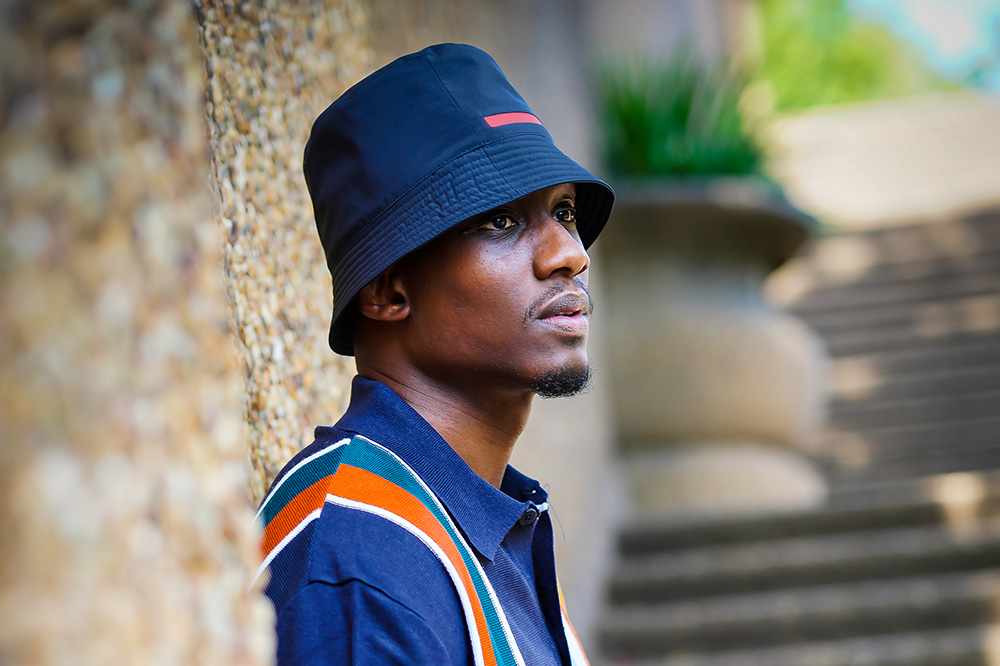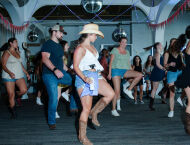Culture
 Pierre Edwards. Photo by Tony Powell.
Pierre Edwards. Photo by Tony Powell.
Culture of Style: Pierre Edwards
July 10, 2020 @ 10:00am
Visual artist Pierre Edwards sees both his work and his personal style as a way to communicate without words.
“The ability to put on a garment and feel a different way has always been very interesting to me,” he says.
He takes inspiration for his sense of fashion from his dad, who immigrated to the United States from Guyana in the 1980s and eventually settled in Prince George’s County, where Edwards was born and raised.
“I remember watching my dad get dressed when I was a kid. It was a special moment to me, just watching him. As a young kid, you geek out about every single thing your dad does. I always remember, like, ‘Man, I can’t wait ‘til I get dressed and put on cologne.’”
His dad’s influence, as well as his Guyanese background, come together in an aesthetic that evokes Caribbean culture and Blue Note Jazz Club artists, with modern elements peppered in. Just as he communicates his heritage through his attire, his creative work is about sharing his experiences.
“For me, being an artist is very much about communicating time, perspective, [and] thoughts and feelings, and trying to speak for individuals [who] maybe don’t necessarily have the medium to speak. It’s always about representing myself, my family and the culture I cling to in the best way I possibly can, and trying to speak for that culture.”
He does this through both his own art studio, District Dodger, and his boutique creative studio for commercial work, Studio Sonic, which he runs with partner Eliud Arbelo.
“District Dodger is the artist and Studio Sonic is the engine,” he explains.
When he’s not crafting narratives for high-profile clients like The Smithsonian, Under Armour and ASICS, he’s sharing his own perspective in video, photographs, stage visuals and conceptual installations. In recent months, his creative work has shifted.
“You speak to the times, and right now for me, it’s very much about wanting to communicate what it means to be Black in America. We’ve gotten to this place [that’s] so divisive. There are people, individuals, brands and corporations that don’t even feel comfortable saying, ‘Black Lives Matter,’ which makes no sense to me. The only thing we’re trying to do is convince equality.”
Edwards became a father last year, and says that has intensified his drive to find purpose in his art.
“It’s hard to even describe the feeling that you have when you look at your child,” he says. “I think the sense of focus and clarity comes on pretty thick when you have a kid.”
His upcoming work was born out of the national reckoning around race and oppression.
“Honestly, this last month-and-a-half has really left an imprint on me that I don’t think will ever wear off. I was an artist that was Black, and I just led by example. But I realized in this time, I have to be more literal.”
Whereas previous exhibits explored theoretical topics like alternate dimensions or ultraviolet light rays, he’s now tackling the concrete issue of racism.
“I don’t have the privilege to create from such an existential place. I can communicate and use my mediums to help spearhead this conversation and make the Black experience in America better. It’s my duty to do so.”
He is currently working with found objects, paint and projections to help others relate to his reality.
“I do honestly think a lot of people just don’t understand and I think that understanding is the first step, right? I’m not into the divisiveness at all. I don’t think that it’s beneficial in any type of capacity. I have the ability to create in a way that can spark conversation [and] understanding, which then will hopefully lead to a better experience for people that look like me.”
His upcoming pieces will comment on the state of policing: a glass display case full of rubber bullets and a projected piece, “Super Predator 2020,” that pushes back against the moniker originating in the ‘90s that villainized young people of color in urban neighborhoods as violent criminals. He hopes telling these stories will lead to greater empathy.
“Without tragedy, there’s no triumph. You have to communicate the tragedy so people can understand the resilience of a people and the power that people hold. I think that a lot of people think when slavery was abolished that everything was cool for Black people, and that’s not true. There’s been many different eras of oppression, even to this day.”
His goal is to direct the proceeds from these projects and future work toward a grant for young Black artists, or to develop a Black art curriculum. Edwards largely credits his hardworking parents for his own successes, and similarly, says his efforts today are for the next generation – especially his own daughter. “I realized that I have to do everything that I can to make this world better for her to live in. That’s my only goal.”
Learn more about Edwards and follow his work on Instagram @districtdodger.
Enjoy this piece? Consider becoming a member for access to our premium digital content and to get a monthly print edition delivered to your door. Support local journalism and start your membership today.







